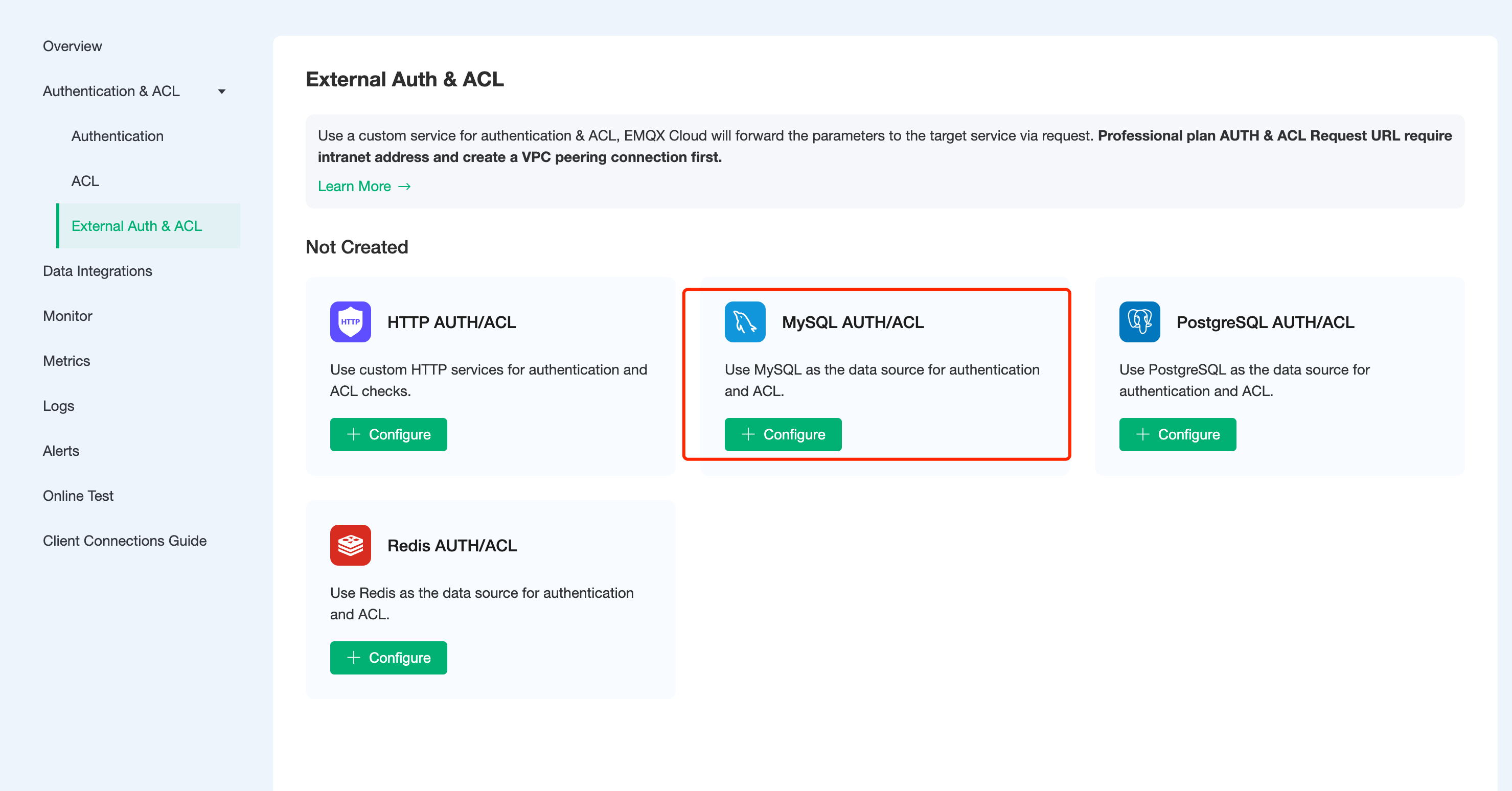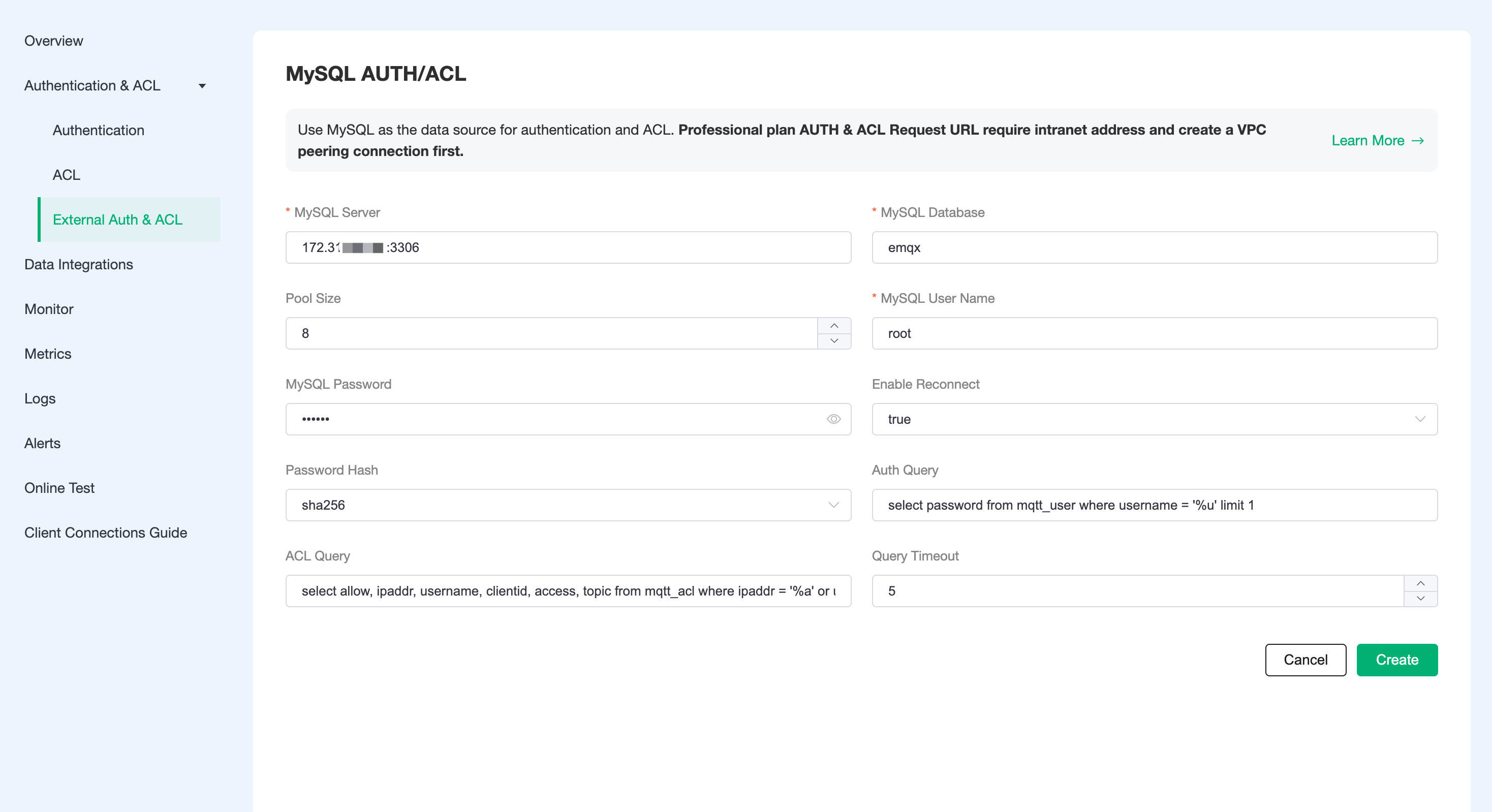MySQL Authentication/Access Control
In addition to supporting the default authentication and authentication method, EMQX Cloud can also use an external MySQL database as a data source to store large amounts of data and to facilitate integration with external device management systems.
Authentication Chain
If default authentication is also enabled, EMQX Cloud will chain default authentication-> MySQL authentication in the following order Authentication.
- Once authentication is successful, the chain is terminated and the client is accessible
- Once authentication fails, terminate the chain and disable client access

ACL Authentication Chain
If multiple ACL modules are enabled at the same time, EMQX Cloud will chain authentication in the order of Default Authentication Database ACL-> MySQL ACL-> System Defaults (All Pub/Sub allowed).
- Once the authentication is passed, terminate the chain and allow the client to pass the authentication
- Once authentication has failed, terminate the chain and deny the client to pass authentication
- Until the last ACL module fails to authenticate, authenticate according to the System default settings --- (All Pub/Sub allowed)

MySQL Configuration
MySQL Installation
bashdocker run -d --restart=always \ --name mysql \ -p 3306:3306 \ -e MYSQL_ROOT_PASSWORD=public \ mysql/mysql-server:5.7Database creation
bashdocker exec -it mysql mysql -uroot -ppublic CREATE DATABASE emqx; USE emqx;Authentication table creation
The following SQL statement will create the
mqtt_usertable, which will be used to store user authentication data.sqlCREATE TABLE `mqtt_user` ( `id` int(11) unsigned NOT NULL AUTO_INCREMENT, `username` varchar(100) DEFAULT NULL, `password` varchar(100) DEFAULT NULL, `salt` varchar(35) DEFAULT NULL, `created` datetime DEFAULT NULL, PRIMARY KEY (`id`), UNIQUE KEY `mqtt_username` (`username`) ) ENGINE=InnoDB DEFAULT CHARSET=utf8mb4;Field Description:
- username: username of the connected client, if the value here is set to $all, the rule applies to all users
- password: password parameter for connecting to the client
- salt: password with salt string
You can use AS syntax in SQL to rename the field to specify password, or set the salt value to a fixed value.
Access Control Table Creation
The following SQL statement will create the
mqtt_acltable, which will be used to store the authentication data of topic subscription and publishing privileges.sqlCREATE TABLE `mqtt_acl` ( `id` int(11) unsigned NOT NULL AUTO_INCREMENT, `allow` int(1) DEFAULT 1 COMMENT '0: deny, 1: allow', `ipaddr` varchar(60) DEFAULT NULL COMMENT 'IpAddress', `username` varchar(100) DEFAULT NULL COMMENT 'Username', `clientid` varchar(100) DEFAULT NULL COMMENT 'ClientId', `access` int(2) NOT NULL COMMENT '1: subscribe, 2: publish, 3: pubsub', `topic` varchar(100) NOT NULL DEFAULT '' COMMENT 'Topic Filter', PRIMARY KEY (`id`), INDEX (ipaddr), INDEX (username), INDEX (clientid) ) ENGINE=InnoDB DEFAULT CHARSET=utf8mb4;Field descriptions:
- allow: disable (0), allow (1)
- ipaddr: set IP address
- username: the username of the connected client, if the value here is set to $all, it means the rule applies to all users
- clientid: client id of the connected client
- access: allowed operations: subscribe (1), publish (2), both subscribe and publish (3)
- topic: the topic of the control, you can use wildcards, and you can add placeholders to the topic to match the client information, e.g. t/%c will replace the topic with the current clientid when matching
Set the EMQX Cloud cluster IP segment to be allowed to access the database (optional)
- For Professional Plan deployment, you can go to the deployment details and navigate to View Peer Connection Information to obtain the deployment's VPC CIDR.
- For BYOC Plan deployment, you can view the peer connection information and obtain the deployment's VPC subnet directly in the public cloud console.
sql# Professional / BYOC GRANT ALL PRIVILEGES ON *. * TO root@'10.11.30.%' IDENTIFIED BY 'public' WITH GRANT OPTION; # Standard GRANT ALL PRIVILEGES ON *. * TO root@'%' IDENTIFIED BY 'public' WITH GRANT OPTION;
Authentication/access control configuration
Click
Authentication Authentication-External Authentication Authorizationin the left menu bar of EMQX Cloud deployment and select MySQL Authentication/Access Control.
Click
Configure Authenticationto enter MySQL Authentication/Access Control page, fill in the information and create a new authentication.TIP
- For Basic Plan users: Please fill in the public address for the server address.
- For Professional Plan users: Please complete Peering Connection Creation first, then fill in the internal network address for the server address.
- For BYOC Plan users: Please establish a peering connection between the VPC where BYOC is deployed and the VPC where the resources are located, then fill in the internal network address for the server address.
- If you are prompted with Init resource failure! check whether the server address is correct, and whether the security group is enabled.

Permissions authentication principle
When authenticating, EMQX Cloud will use the current client information to populate and execute the username and password authentication SQL configured by the user, and query the authentication data in the database for that client.
select password from mqtt_user where username = '%u' limit 1;You can use the following placeholders in the authentication SQL, which will be automatically populated with the client information when EMQX Cloud is executed: :
- %u: username
- %c: clientid
- %P: plaintext password
You can adapt the authentication SQL to your business needs, such as adding multiple query conditions, using database preprocessing functions, to achieve more business-related functionality. But in any case, the authentication SQL needs to meet the following conditions:
- The query result must contain a password field. EMQX Cloud uses this field to compare with the client password. If other encryption methods other than plain are selected, the password field in the
mqtt_usertable needs to insert the string encrypted by the corresponding encryption algorithm. - If the salt configuration is enabled, the query result must contain the salt field, which is used by EMQX Cloud as the salt value.
- There can only be one query result, and only the first result is taken as valid data when there are multiple results.
The default configuration example data is as follows.
INSERT INTO `mqtt_user` ( `username`, `password`, `salt`)
VALUES
('emqx', 'efa1f375d76194fa51a3556a97e641e61685f914d446979da50a551a4333ffd7', NULL);With MySQL authentication enabled, you can connect via username: emqx, password: public.
Access control principle
When access control authentication is performed for topic subscription and publishing, EMQX Cloud will use the current client information to populate and execute the user-configured access control authentication SQL to find the data related to the client from MySQL and then perform authentication.
select allow, ipaddr, username, clientid, access, topic from mqtt_acl where ipaddr = '%a' or username = '%u' or username = '$all' or clientid = '%c';The following placeholders can be used in the authentication SQL and will be automatically populated with client information by EMQX Cloud when executed: :
- %u: username
- %c: clientid
- %a: client IP address
- %P: plaintext password
The following example data is configured by default.
-- All users are not allowed to subscribe to system topics
INSERT INTO mqtt_acl (allow, ipaddr, username, clientid, access, topic) VALUES (0, NULL, '$all', NULL, 1, '$SYS/#');
-- Allow clients on 10.59.1.100 to subscribe to system topics
INSERT INTO mqtt_acl (allow, ipaddr, username, clientid, access, topic) VALUES (1, '10.59.1.100', NULL, NULL, 1, '$SYS/#');
-- Disable client subscription to /smarthome/+/temperature topic
INSERT INTO mqtt_acl (allow, ipaddr, username, clientid, access, topic) VALUES (0, NULL, '$all', NULL, 1, '/smarthome/+/temperature');
-- Allow clients to subscribe to the /smarthome/${clientid}/temperature topic containing their own Client ID
INSERT INTO mqtt_acl (allow, ipaddr, username, clientid, accessEncryption rules
Most external authentication on EMQX Cloud can be enabled with the hash method, and only the cipher text of the password is stored in the data source to ensure data security. When hashing is enabled, you can specify a salt for each client and configure the salt rules, and the password stored in the database is the cipher text processed according to the salt rules and the hashing method.
Available from: Salting rules and hashing methods。
## unsalted, plaintext
plain
## No salt, hash only
sha256
## salt prefix: use sha256 to encrypt the salt + password concatenated string
salt,sha256
## salt suffix: encrypted with sha256 password + salt concatenated string
sha256,salt
## pbkdf2 with macfun iterations dklen
## macfun: md4, md5, ripemd160, sha, sha224, sha256, sha384, sha512
pbkdf2, sha256, 1000, 20